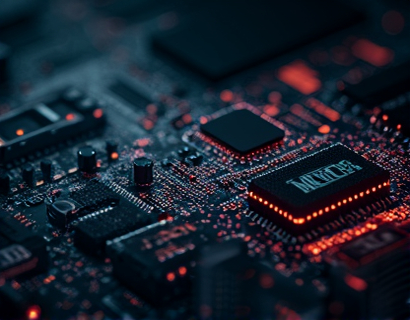DeFi Trading Enhanced: Mastering Automated Market Makers with Advanced Smart Contracts
In the rapidly evolving world of decentralized finance, or DeFi, traders and enthusiasts are constantly seeking ways to optimize their trading strategies and enhance liquidity management. One of the most transformative advancements in this space is the integration of Automated Market Makers (AMMs) powered by advanced smart contracts. These technologies are redefining the landscape of decentralized trading, offering unprecedented levels of efficiency, automation, and accessibility. This article delves into the intricacies of AMMs, exploring how advanced smart contracts are revolutionizing the way crypto traders interact with the market.
Understanding Automated Market Makers
Traditional market makers in centralized exchanges manually manage liquidity and set bid-ask spreads to facilitate trades. In contrast, AMMs are decentralized protocols that use mathematical formulas and liquidity pools to determine prices and execute trades. The core idea behind AMMs is to create a liquidity pool where users can deposit tokens, typically in a fixed ratio, to provide liquidity to the platform. This pool is then used to facilitate trades without the need for a traditional order book.
AMMs operate on the principle of constant product mapping, where the product of the two token quantities in a liquidity pool remains constant. For example, in a pool with tokens A and B, the equation x * y = k remains constant, where x and y are the quantities of tokens A and B, and k is a constant. When a trade occurs, the quantities of A and B adjust according to this formula, ensuring that the pool remains balanced. This mechanism eliminates the need for a central authority to manage liquidity, reducing costs and increasing efficiency.
Advantages of AMMs Over Traditional Markets
One of the primary advantages of AMMs is their ability to provide continuous liquidity without the need for deep order books. Traditional exchanges require a significant amount of liquidity to support large trades, which can lead to slippage and higher transaction costs. AMMs, on the other hand, can handle trades of any size without significant price impact, making them ideal for both small and large transactions.
Another significant benefit is the reduced counterparty risk. In centralized exchanges, traders rely on the exchange to execute trades and hold their funds, which can be a point of failure. AMMs eliminate this risk by allowing users to interact directly with smart contracts, ensuring that trades are executed automatically and securely. This decentralized approach not only enhances security but also promotes transparency, as all transactions are recorded on the blockchain.
Advanced Smart Contracts in AMMs
The true power of AMMs lies in the advanced smart contracts that underpin their functionality. These smart contracts are programmed to enforce the rules of the liquidity pool, manage trades, and ensure the integrity of the system. Let's explore some of the key features and innovations in smart contracts that enhance the trading experience in DeFi.
Liquidity Providing and Rewards
One of the most compelling aspects of AMMs is the incentive structure for liquidity providers. Smart contracts can automatically distribute tokens or native rewards to users who provide liquidity to the pool. These rewards can be in the form of governance tokens, staking rewards, or other incentives designed to encourage participation. The smart contract ensures that rewards are distributed fairly and transparently, based on predefined rules.
Moreover, advanced smart contracts can implement dynamic fee structures, where the trading fee rate adjusts based on the level of liquidity in the pool. When liquidity is low, fees increase to attract more providers, and vice versa. This mechanism helps maintain optimal liquidity levels and ensures that the market remains efficient.
Order Management and Execution
Smart contracts in AMMs are designed to handle complex order management and execution processes. Users can place limit orders, market orders, and even more sophisticated orders like stop-loss and take-profit orders directly through the smart contract. The contract executes these orders based on the current price determined by the liquidity pool's formula, ensuring fair and transparent trading.
For instance, when a user places a market order to buy a token, the smart contract calculates the equivalent amount of the other token in the pool based on the current price. It then deducts the required tokens from the user's wallet and adds the corresponding tokens to the user's account, updating the liquidity pool accordingly. This process happens atomically, meaning it is executed as a single, indivisible operation, preventing any potential exploits or discrepancies.
Risk Management and Governance
Advanced smart contracts also incorporate robust risk management features to protect both liquidity providers and traders. For example, smart contracts can implement maximum withdrawal limits to prevent liquidity pools from being drained by malicious actors. Additionally, they can enforce collateral requirements to ensure that users have sufficient assets to cover potential losses.
Governance tokens play a crucial role in the management and evolution of AMMs. These tokens give holders a voice in the protocol's development, allowing the community to propose and vote on upgrades, fee adjustments, and other critical decisions. This decentralized governance model ensures that the AMM remains aligned with the needs and preferences of its users.
Optimizing Liquidity Management with Smart Contracts
Liquidity management is a critical aspect of DeFi trading, and advanced smart contracts offer powerful tools to optimize this process. By automating liquidity provision, fee management, and reward distribution, smart contracts reduce the complexity and effort required to manage liquidity pools effectively.
One of the key benefits is the ability to set up automated rebalancing strategies. Smart contracts can monitor the ratio of tokens in the liquidity pool and automatically adjust deposits or withdrawals to maintain the desired ratio. This ensures that the pool remains well-liquidated and attractive to traders, even during periods of high volatility.
Furthermore, smart contracts can integrate with other DeFi protocols, such as lending and borrowing platforms, to create composite financial products. For example, a liquidity provider can earn interest on their deposited tokens while also participating in yield farming opportunities. The smart contract can automatically manage these multiple streams of income, maximizing returns for the provider.
Enhancing Trading Strategies with Advanced Features
Advanced smart contracts in AMMs offer a range of features that can significantly enhance trading strategies. Traders can leverage these features to execute complex trades, manage risk, and optimize returns.
Arbitrage and Market Making
Arbitrage opportunities are abundant in the DeFi space due to the decentralized and fragmented nature of exchanges. Advanced smart contracts can detect price discrepancies across different AMMs and execute arbitrage trades automatically. This not only helps in capitalizing on small price differences but also contributes to price convergence across the ecosystem.
Market making is another strategy that benefits from AMMs. Traders can deploy smart contracts that automatically provide liquidity and adjust positions based on market conditions. For example, a smart contract can monitor the price movement of a token and dynamically adjust the amount of liquidity provided to maximize profits from trading fees.
Risk Parity and Portfolio Optimization
Risk parity is a trading strategy that allocates capital based on the volatility of assets rather than their value. Advanced smart contracts can implement risk parity strategies by dynamically adjusting the allocation of tokens in a liquidity pool to maintain an optimal risk profile. This ensures that no single asset disproportionately affects the overall risk of the portfolio.
Portfolio optimization is another advanced feature enabled by smart contracts. By analyzing historical price data and market trends, smart contracts can recommend optimal token allocations to maximize returns while minimizing risk. This data-driven approach allows traders to make informed decisions and adapt their strategies in real-time.
Challenges and Considerations
While advanced smart contracts in AMMs offer numerous benefits, there are also challenges and considerations that users should be aware of. Security remains a top concern, as smart contracts are only as secure as their code. Bugs, vulnerabilities, and exploits can lead to significant losses. Therefore, thorough audits and testing are essential to ensure the reliability of the smart contracts.
Another consideration is the user experience. While smart contracts provide powerful functionality, they can be complex and difficult for novice users to interact with. User-friendly interfaces and educational resources are crucial to democratize access to these advanced tools.
Conclusion
The integration of advanced smart contracts in Automated Market Makers is transforming the landscape of DeFi trading. By automating liquidity management, enhancing trading strategies, and providing robust risk management features, these technologies are making decentralized finance more accessible, efficient, and user-friendly. As the ecosystem continues to evolve, we can expect even more innovative solutions that further enhance the trading experience for crypto enthusiasts and professionals alike.











































